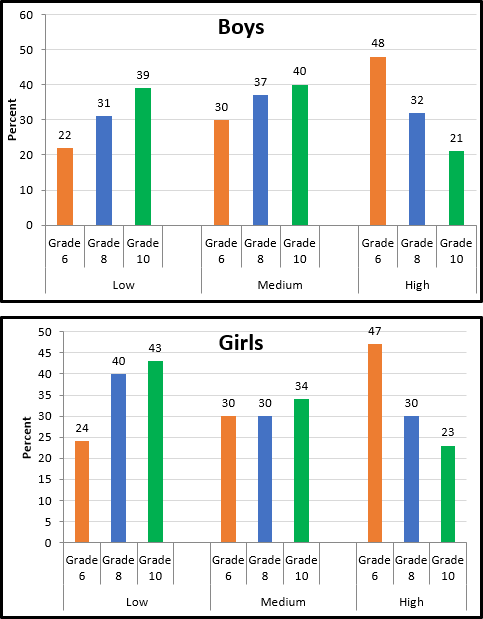7.3.3 Percentage of youth in Grades 6, 8 and 10 who report low, medium and high levels of family support, by gender, Canada, 2014

Source: CICH graphic created using data from Health Behaviour in School-aged Children in Canada: Focus on Relationships, 2015.
According to a scale* measuring youth in Grades 6, 8 and 10 reports of family support, there were differences in reported family support among Grade levels.
Students in Grade 6 were the most likely to report that they had high family support and least likely to have low family support. Students in Grade 10 had the opposite experience.
The only difference between girls and boys is in Grade 8, with girls being more likely to be in the low group than were boys.
*The scale is based on the following questions:
My family really tries to help me.
I get the emotional help and support I need from my family.
I can talk about my problems with my family.
My family is willing to help me make decisions.
Answers: Strongly disagree; Disagree; Neither agree nor disagree: Agree; Strongly agree
Implications
Young people who have strong family support have more positive developmental outcomes.1,2 For example, family support is associated with school graduation rates, teen parenthood, obesity and adult outcomes such as income level and employment.3,4
According to the Health Behaviours Survey of School Age Children, strong family support was associated with higher levels of being physically active, lower levels of sedentary behaviours, less difficulty in getting to sleep, lower likelihood of going to school tired, and higher probability of eating fruits once a day or more. Students were also less likely to eat in fast food restaurants and less likely to go to school or bed hungry. Young people were more likely to have the recommended amount of sleep, be less likely to experience weight-related teasing, less likely to smoke, drink alcohol, or use cannabis and were less likely to be involved in bullying behaviours – either as bullies or victims. Family support was strongly related to life satisfaction.5
1Elgar, F. J., Craig, W., & Trites, S. J. (2012). Family dinners, communication and mental health in Canadian adolescents. Journal of Adolescent Health, 52(4), 433-438.
2Gutman, L. M., & Eccles, J. S. (2007). Stage-environment fit during adolescence: trajectories of family relations and adolescent outcomes. Developmental Psychology, 43, 522-537.
3Duncan, G. J., Ziol-Guest, K. M., & Kalil, A. (2010). Early childhood poverty and adult attainment, behaviour, and health. Child Development, 81(1), 306-325.
4Pungello, E. P., Kainz, K., Burchinal, M., Wasik, B. H., Sparling, J. J., Ramey, C. T., & Campbell, F. A. (2010). Early educational intervention, early cumulative risk, and the home environment as predictors of young adult outcomes within a high-risk sample. Child Development, 81, 410-426.
5Freeman JG, King M and Pickett W. Health Behaviour in School-aged Children (HBSC) in Canada: Focus on Relationships. 2016.
http://healthycanadians.gc.ca/publications/science-research-sciences-recherches/health-behaviour-children-canada-2015-comportements-sante-jeunes/index-eng.php
